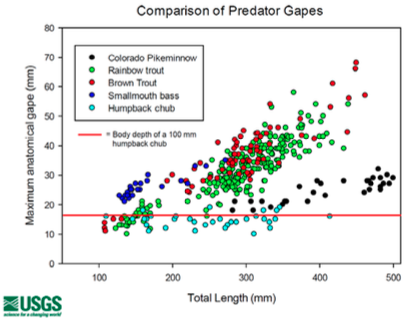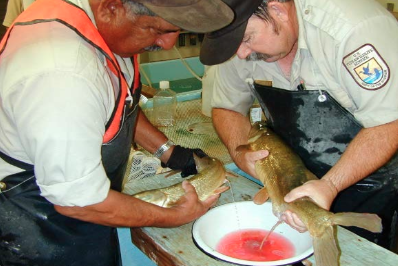The Colorado River is a vital resource to millions of humans surrounding it, providing water resources for agricultural irrigation, municipal water use, mining operations, recreation and more. However, the natural ecosystems have been disturbed by harnessing this system through the construction of extensive water storage and conveyance infrastructure, specifically dams. Additionally, invasive species resilient to these ecosystem changes have thrived, growing in population size rapidly. This has created an unhealthy environment for native species to survive in, resulting in the extirpation of several native fish species to the Colorado River Basin.
What is extirpation and which species have been effected?
Extirpation is the absence of a species or population from a geographic location where it was previously present. This is an important phenomenon because local extirpation has been linked as a precursor to more widespread regional or global scarcity and increased risk of extinction. The loss of native species to an area also indicates a loss or shift in ecosystem services and food web dynamics. Here we examine the extirpation of three native fish species, the Colorado pikeminnow (Ptychocheilus lucius), the Bonytail chub (Gila elegans), and the Roundtail chub (Gila robusta).
The Colorado pikeminnow and Bonytail chub are both currently classified as endangered species, while the Roundtail chub is not listed, but close to being considered a threatened species. Their diet ranges from insect larvae and plant matter to other fishes. The Colorado pikeminnow is the largest of the three, growing close to six feet long, while the chub species grow up to one and half to two feet in length.
Why is extirpation occurring?
The construction of dams has greatly changed the Colorado River and the ecosystems found within it. These dams regulate the flow rate of the river, the amount of sediment being transported with the flow, the temperature of the water and dampen previously pronounced seasonable flow dynamics. Before dams, the Colorado River experienced seasonal flooding associated with snowmelt in the spring, transporting large amounts of sediment. The river was much more turbid and had lower amounts of benthic algae present than in its current state. These shifts in the ecosystem can affect the availability of food and suitable spawning habitats for these endangered species. Additionally, the growth of invasive fish species in the Colorado River have effectively outcompeted these endangered natives. While fish like rainbow trout, brown trout and smallmouth bass are lauded for their sport fishing value, they are also very adaptable, and have pushed native species out as they compete with them, or in the case of the humpback chub, hunt them as a food source. The extirpated species are gape-limited, meaning they can only swallow food as wide as their mouths.
The invasive species generally have a larger gape to body length ratio, an important advantage when competing for limited food sources. These compounding factors of natural habitat degradation and competition from invasive species has caused the current state of extirpation we observe today.

How can we solve this problem?
The Colorado pikeminnow is a good case study to examine how extirpation can be addressed through policy and management. There are two major components to
addressing species extirpation. The first is active management programs established to grow populations, and the second is the implementation of population/life history surveys to parameterize models, which can be used to advise future management scenarios.
The Grand Canyon National Park Native Fish Restoration Plan aims to restore extirpated fish populations to as close to historic levels as is possible, through the restoration of their natural habitats, and by reestablishing a self-sustaining population. One way that endangered fish populations are increased is through captive broodstocks, where fish are bred in captivity, and subsequently released into the wild. This is currently being done with the Colorado pikeminnow at the southwestern Native Aquatic Resource and Recovery Center in Dexter, New Mexico. Artificial spawning is conducted by squeezing the male fish’s sperm onto the female fish’s eggs. One important consideration in these breeding programs is genetic diversity, and spawning matrices are created so that the maximum amount of genetic diversity is preserved.

It is also possible to implement tag and release programs at these breeding facilities, which aid in the implementation of population surveys for modelling. There are multiple types of fish tags available, ranging from fluorescent dyes to physical chip implementation. Each has pros and cons, including ease of installation and ease of recovery (deadly vs. non-deadly). However, they all provide important data on fish populations, including population size estimates, rates of survivorship, habitat usage, migratory patterns, and growth estimates. This culminates in a life history snapshot for tagged fish, indicating the health of the species and the ability of the ecosystem to support it.
Researchers can use this data to estimate extinction probabilities under different management and reintegration scenarios. However, this is not a simple process. Many organizations oversee and have a say in the reintegration plans, including the National Parks Service, United States Fish and Wildlife Service and Bureau of Reclamation to name a few. Comprehensive plans must include all relevant info regarding the species current status and role in an ecosystem, regulations regarding fish transport and release must be followed, and monitoring post release must occur to determine the relative success of the management plan.
Although it is a relatively complicated process, the management of extirpated species is vital to preserving the natural ecosystem diversity of this region. Further research should shed more light on the dynamics of the Colorado River, and hopefully increase our success in reestablishing native fish species to their natural habitats.
Additional Reading:
Minckley, W. L et. al. (2003). A Conservation Plan for Native Fishes of the Lower Colorado River. BioScience, 53(3), 219–234.
